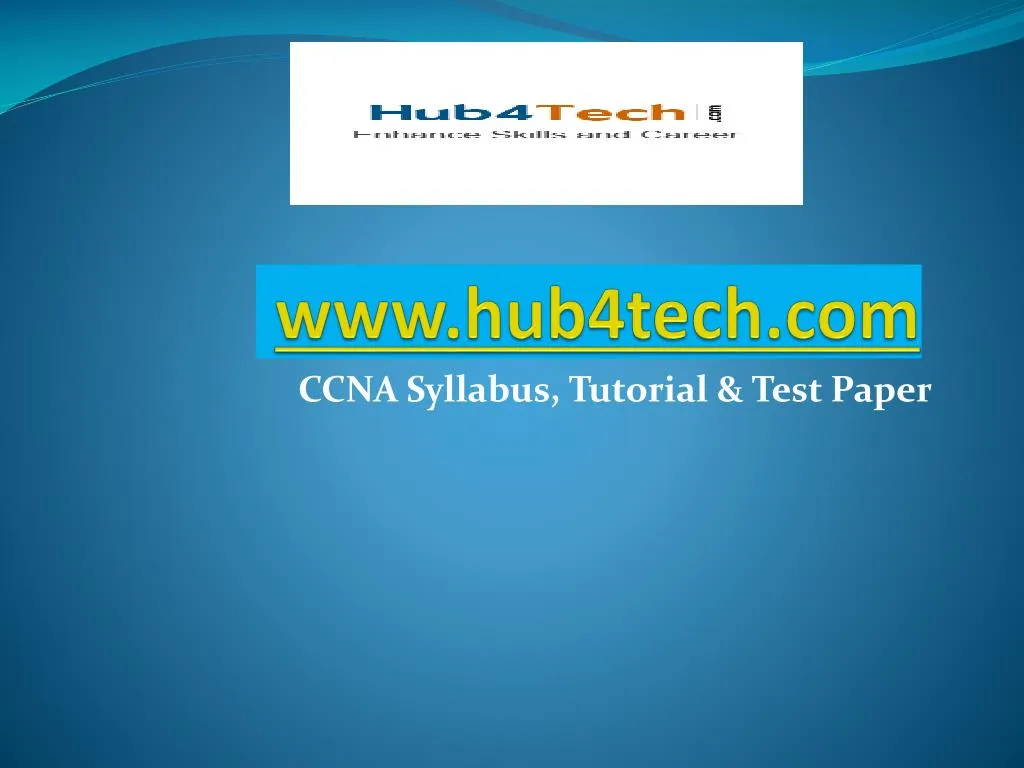210-455 Cldadm Pdf Free Download
![]() Download
Download

Skip this Video
Loading SlideShow in 5 Seconds..
CCNA Exam Syllabus PowerPoint Presentation


CCNA Exam Syllabus
Download Presentation
CCNA Exam Syllabus
- - - - - - - - - - - - - - - - - - - - - - - - - - - E N D - - - - - - - - - - - - - - - - - - - - - - - - - - -
Presentation Transcript
-
www.hub4tech.com CCNA Syllabus, Tutorial & Test Paper
-
CCNA Exam Syllabus Exam Description – • CCNA Exam: The 200-120 CCNA exam is the composite exam associated with the CCNA Routing • and Switching certification. Candidates can prepare for this exam by taking the Interconnecting • Cisco Networking Devices Part 1 (ICND1) v2.0 and the Interconnecting Cisco Networking Devices • Part 2 (ICND2) v2.0 courses. This exam tests a candidate's knowledge and skills required to install, • operate, and troubleshoot a small to medium-size enterprise branch network. The topics include all • the areas covered under the 100-101 ICND1 and 200-101 ICND2 exams.
-
Exam Topics - • The following topics are general guidelines for the content likely to be included on the CCNA • Composite exam. However, other related topics may also appear on any specific delivery of the • exam. The guidelines below may change at any time without notice in order to better reflect the • contents of the exam and for clarity purposes.
-
Operation of IP Data Networks - • Recognize the purpose and functions of various network devices such as Routers, Switches, • Bridges and Hubs. • Select the components required to meet a given network specification. • Identifycommon applications and their impact on the network • Describe the purpose and basic operation of the protocols in the OSI and TCP/IP models. • Predict the data flow between two hosts across a network. • Identify the appropriate media, cables, ports, and connectors to connect Cisco network • devices to other network devices and hosts in a LAN
-
LAN Switching Technologies • Determine the technology and media access control method for Ethernet networks • Identify basic switching concepts and the operation of Cisco switches. • Collision Domains • Broadcast Domains • Types of switching • CAM Table • Configure and verify initial switch configuration including remote access management. • Cisco IOS commands to perform basic switch setup • Verify network status and switch operation using basic utilities such as ping, telnet and ssh. • Describe how VLANs create logically separate networks and the need for routing between them. • Explain network segmentation and basic traffic management concepts • Configure and verify VLANs • Configure and verify trunking on Cisco switches • DTP • Auto negotiation
-
IP addressing (IPv4 / IPv6) - • Describe the operation and necessity of using private and public IP addresses for IPv4 addressing. • Identify the appropriate IPv6 addressing scheme to satisfy addressing requirements in a LAN/WAN environment. • Identify the appropriate IPv4 addressing scheme using VLSM and summarization to satisfy addressing requirements in a LAN/WAN environment. • Describe the technological requirements for running IPv6 in conjunction with IPv4 such as dual stack. • Describe IPv6 addresses • Global unicast • Multicast • Link local • Unique local • eui 64 • autoconfiguration
-
IP Routing Technologies- • Describe basic routing concepts • CEF • Packet forwarding • Router lookup process • Configure and verify utilizing the CLI to set basic Router configuration • Cisco IOS commands to perform basic router setup • Configure and verify operation status of an Ethernet interface • Verify router configuration and network connectivity • Cisco IOS commands to review basic router information and network connectivity • Configure and verify routing configuration for a static or default route given specific routing requirements • Differentiate methods of routing and routing protocols • Static vs. Dynamic • Link state vs. Distance Vector
-
• next hop • ip routing table • Passive interfaces • Configure and verify OSPF (single area) • Benefit of single area • Configure OSPF v2 • Configure OSPF v3 • Router ID • Passive interface • Configure and verify interVLAN routing (Router on a stick) • sub interfaces • upstream routing • encapsulation • Configure SVI interfaces
-
IP Services- • Configure and verify DHCP (IOS Router) • configuring router interfaces to use DHCP • DHCP options • excluded addresses • lease time • Describe the types, features, and applications of ACLs • Standard • Sequence numbers • Editing • Extended • Named • Numbered • Log option • Configure and verify ACLs in a network environment
-
• Named • Numbered • Log option • Identify the basic operation of NAT • Purpose • Pool • Static • 1 to 1 • Overloading • Source addressing • One way NAT • Configure and verify NAT for given network requirements • Configure and verify NTP as a client
-
Network Device Security – • Configure and verify network device security features such as: • Device password security • Enable secret vs enable • Transport • Disable telnet • SSH • VTYs • Physical security • Service password • Describe external authentication methods • Configure and verify Switch Port Security features such as • Sticky MAC • MAC address limitation
-
• Static / dynamic • Violation modes • Err disable • Shutdown • Protect restrict • Shutdown unused ports • Err disable recovery • Assign unused ports to an unused VLAN • Setting native VLAN to other than VLAN 1 • Configure and verify ACLs to filter network traffic • Configure and verify an ACLs to limit telnet and SSH access to the router
-
Troubleshooting - • Troubleshoot and correct common problems associated with IP addressing and host configurations. • Troubleshoot and Resolve VLAN problems • identify that VLANs are configured • port membership correct • IP address configured • Troubleshoot and Resolve trunking problems on Cisco switches • correct trunk states • correct encapsulation configured • correct vlans allowed • Troubleshoot and Resolve ACL issues • Statistics
-
• Permitted networks • Direction • Interface • Troubleshoot and Resolve Layer 1 problems • Framing • CRC • Runts • Giants • Dropped packets • Late collision • Input / Output errors
-
LAN Switching Technologies - • Identify enhanced switching technologies • RSTP • PVSTP • Ether channels • Configure and verify PVSTP operation • describe root bridge election • spanning tree mode
-
IP Routing Technologies - • Describe the boot process of Cisco IOS routers • POST • Router boot up process • Configure and verify operation status of a Serial interface • Manage Cisco IOS Files • Boot preferences • Cisco IOS image(s) • Licensing • Show license • Change license • Differentiate methods of routing and routing protocols • Administrative distance • split horizon • metric • next hop
-
• Configure and verify OSPF (single area) • neighbor adjacencies • OSPF states • Discuss Multi area • Configure OSPF v2 • Configure OSPF v3 • Router ID • LSA types • Configure and verify EIGRP (single AS) • Feasible Distance / Feasible Successors /Administrative distance • Feasibility condition • Metric composition • Router ID • Auto summary • Path selection • Load balancing • Equal • Unequal • Passive interface
-
IP Services - • Recognize High availability (FHRP) • VRRP • HSRP • GLBP • Configure and verify Syslog • Utilize Syslog Output • Describe SNMP v2 & v3
-
Troubleshooting - • Identify and correct common network problems • Utilize netflow data • Troubleshoot and Resolve Spanning Tree operation issues • root switch • priority • mode is correct • port states • Troubleshoot and Resolve routing issues • routing is enabled • routing table is correct • correct path selection • Troubleshoot and Resolve OSPF problems • Neighbor Adjacencies • Hello and Dead timers • OSPF area • Interface MTU • Network types • Neighbor states
-
• OSPF topology database • Troubleshoot and Resolve EIGRP problems • neighbor advances • AS number • Load balancing • Split horizon • Troubleshoot and Resolve inter VLAN routing problems • Connectivity • Encapsulation • Subnet • Native VLAN • Port mode trunk status • Troubleshoot and Resolve WAN implementation issues • Serial interfaces • PPP • Frame relay • Monitor NetFlow statistics • Troubleshoot etherchannel problems
-
WAN Technologies - • Identify different WAN Technologies • Metro Ethernet • VSAT • Cellular 3G / 4G • MPLS • T1 / E1 • ISDN • DSL • Frame relay • Cable • VPN • Configure and verify a basic WAN serial connection • Configure and verify a PPP connection between Cisco routers • Configure and verify Frame Relay on Cisco routers • Implement and troubleshoot PPPoE
-
Hub4Tech.com provides online Skill Test, Tutorial, Jobs, Certified Resumes and Marketplace for Freelancers & Trainers. CCNA Tutorial - http://www.hub4tech.com CCNA Test Paper - http://www.hub4tech.com www.facebook.com/hub4tech www.youtube.com/c/TechnologypartnerInNoida
-
THE End
Posted by: leonelleonelbroste0271897.blogspot.com
Source: https://www.slideserve.com/technologypartner/ccna-exam-syllabus

Post a Comment for "210-455 Cldadm Pdf Free Download"